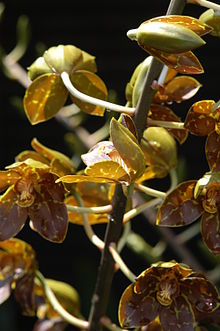|
Grammatophyllum speciosum
Grammatophyllum speciosum, also called giant orchid, tiger orchid, sugar cane orchid or queen of the orchids, is a species of orchid native to Laos, Myanmar, Thailand, Vietnam, Borneo, Indonesia (Sumatra, Java, Sulawesi) and Malaysia. It has also been recorded in the Philippines, New Guinea and the Solomon Islands. It is listed by the Guinness Book of World Records as the world's tallest orchid, with specimens recorded up to 7.62 metres (25 ft) in height.[3] Description It is an epiphytic and occasionally a lithophytic plant, forming spectacular root bundles. Its cylindric pseudobulbs can grow to a length of 2.5 m. It can grow to gigantic clusters weighing from several hundred kilograms to more than one ton.[4] One collected in 1893 by Frederick K. Sander & Co. near Penang Island in Malaysia weighed a long ton (=a metric ton). Half was sent to the Columbian Exhibition in Chicago and the other half to the Singapore Botanic Garden.[5] By 1902, the Singapore specimen had grown to be 47 feet (14 meters) in girth by ten feet (three meters) high and bore simultaneously 2090 five-inch-wide flowers plus 1110 unopened buds.[6] Much more recently, in A.D. 2000, biologists Tim Laman and Phil Atkinson found one in Borneo 25 feet (7.6 meters) wide and bearing between 2500 and 5000 flowers. The plant completely encircled the host tree 150 feet (46 meters) above ground.[7][8] The oldest individual orchid plant is also a G. speciosum. Planted in the Singapore Botanic Garden in 1861 by Garden Director Lawrence Niven and his staff, it was 154 years old in 2015.[9] and so would now (2022) be 161 years of age. The plant is also five meters (16 feet) in width. Each raceme can grow to a height of 3m, bearing up to eighty flowers, each 10 cm wide. The flowers are yellow colored with maroon or dark red spots. These flowers are remarkable, since the lowest flowers have no lip and these flowers function as osmophores for the entire inflorescence and continue to emit chemical scent to attract pollinators as flowers open in succession. It blooms only once every two to four years. This orchid can, however, remain in bloom for up to two months. Each individual flower can remain fresh for as long as six weeks.[10] In addition, this plant has been found to have potential medicinal benefits; for example one research article by Harikarnpakdee and Chowjarean found it specifically aided in wound healing in humans.[11] Common names
Distribution and habitatIt is native to New Guinea, Thailand, Indonesia, Malaysia and Philippines, growing in crotches of large trees on exposed areas of the lowland tropical rainforest.[16] EcologyA giant orchid weighing two tons was one of the highlights in the 1851 exhibition at the Crystal Palace in London. Because of its enormous size, it is rarely cultivated as this species is usually too large to be accommodated in most greenhouses. Cultivated specimens of this species are always grown as terrestrials, as the plants grow as both an epiphyte and terrestrial in habitat.[17] References
External links
|
||||||||||||||||||||||||||||||||
